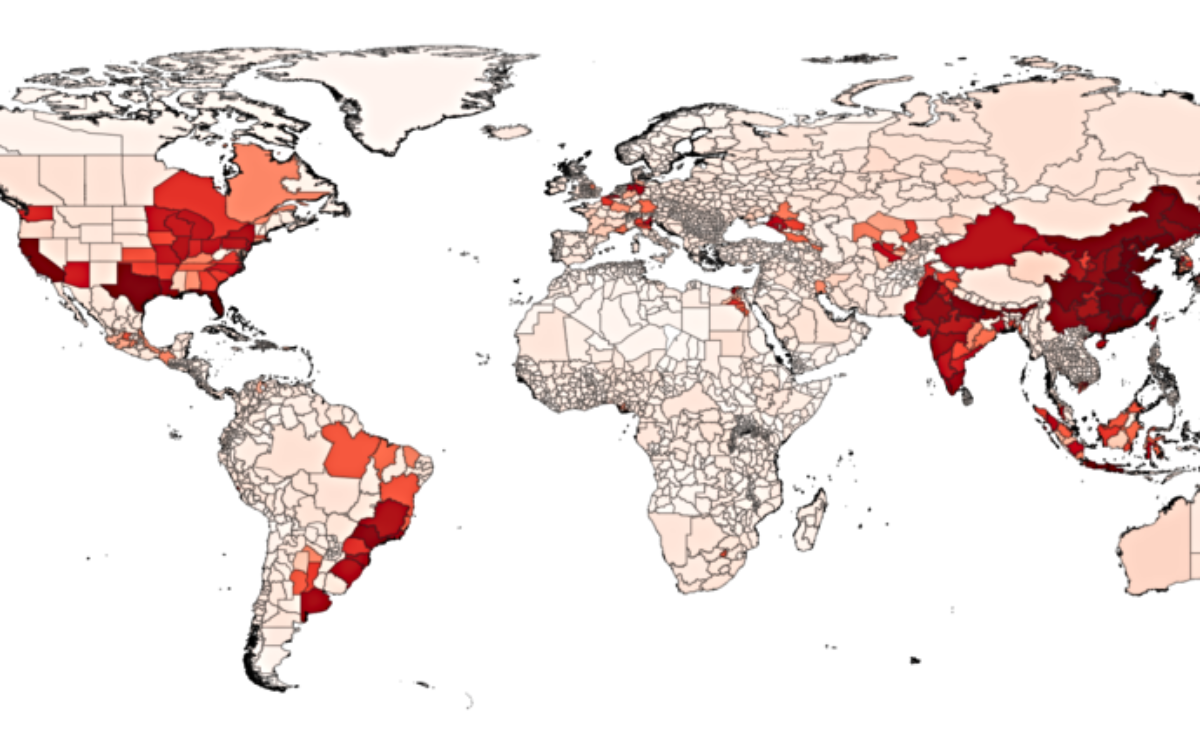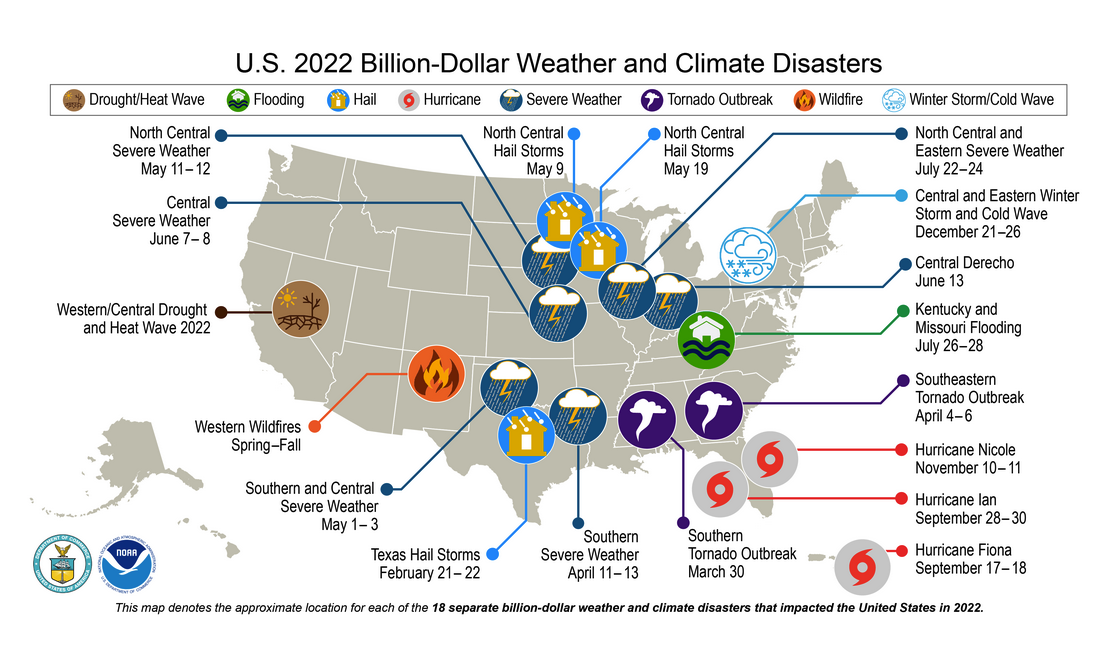Leer esta página en: Español

New data highlighting extreme vulnerability of the global built environment ranks Florida, California, and Texas top among U.S. states to suffer from climate change.
Greg Harman
As the leading exporter of fossil fuels and petrochemicals in the United States, Texas is home to a massive (and growing) conglomeration of multimillion-dollar industrial facilities across the Gulf Coast. Those facilities—just as the rising human populations around them in cities like Houston and Corpus Christi—exist at extreme risk from the accelerating climate crisis being propelled largely by these same fossil fuel facilities.
Billion-dollar weather-driven disasters have hit Texas with increasing ferocity in recent decades as global warming has ramped up. There were 14 such disasters in the 1980’s, 21 in the 1990’s, 25 in the 2000’s, and 60 between 2010 and 2020, according to National Oceanic and Atmospheric Administration records.
A new report assessing global climate risk to the built environment via XDI, which bills itself as a global leader in physical climate risk analysis, identifies Florida, California, and Texas as among some of the most threatened territories on the planet due to global warming impacts. The Gross Domestic Climate Risk assessment is prepared largely with financial firms in mind and examines risks to residential, industrial, or commercial environments threatened by climate change. It reminds us that everything we’ve built at this human-industrial nexus exists within a state of growing risk from sea-level rise, strengthening storms, extreme heat, and drought, among other outcomes of our packing the atmosphere with increasing levels of heat-trapping gases.

More than half of the top 200 territories deemed at most extreme risk for infrastructure damage exist in Asia, according to XDI. And 29 of China’s state are in the report’s top 100.
Among the risks to the built environment considered are: flooding, coastal inundation, extreme heat, forest fire, soil subsidence, and extreme wind, including from hurricanes and tornadoes.
Africa, understood to be the most climate-vulnerable continent, doesn’t rank highly only because this survey focuses on the built environment and does not examine “social, environmental and economic impacts from effects such as water shortages, or impacts on agricultural production, biodiversity or human well-being,” XDI’s website states.
Texas is highlighted by XDI alongside a handful of other US states saddled by similar risks threatening other spotlighted regions of the Earth. Florida (scoring 10), California (19), and Texas (20), lead the ranking of the most vulnerable US states with high aggregated damage ratios—a scoring system that considers the total amount of damage to the built environment expected due to extreme weather events driven by climate change—followed by Illinois (53) and Arizona (87).

The dataset and rankings are geared toward the financial sector to “underscore the importance of pricing physical climate risk,” the release states. This is critical “given the amount of capital investment represented by the assets at risk in the provinces identified, the vulnerability of global supply chains, and the need for climate resilience to inform investment.”
Of course, while groups like XDI are passing along critical information to, say, insurance companies who are retreating from states like Florida due to disaster costs, the the response from Republican state leaders in Texas has been to attack any financial institution that tries to incentivize movement away from fossil fuels.
Last year, Texas Lt. Governor Dan Patrick instructed Comptroller Glenn Hegar to include Black Rock, for example, among a list of financial firms “boycotting oil and gas.” (Black Rock, in a document released to Deceleration under state open-records law, objected that they have $251B invested globally in oil and gas—and $91B in Texas oil and gas companies, in particular.)
According to the United States Fourth National Climate Assessment, the Texas Gulf Coast is among the areas most vulnerable to climate change due to rising seas and storm surge. The report also highlights the risk of “cascading failures” across the region from potential disruption of coastal refineries, resulting in fuel shortages and increasing energy costs.
An anticipated $34B coastal barrier project at Galveston Island known as the “Ike Dike” is expected to offset some risk for the greater Houston area when it is completed—possibly more than $2B of damages per year.

XDI US State Ratings
Florida (10)
California (19)
Texas (20)
Illinois (53)
Arizona (87)
Indiana (88)
XDI Highlights on US States
- Sea level rise is a driving hazard for many states. The US Fourth National Climate Assessment found that sea level rise rates along the Mid-Atlantic Coast were three to four times higher than the global average rate. In the Mid-West, the highest ranking states are those that have both escalating risk from both flood and wildfire.
- The US has experienced 332 weather and climate related disasters since 1980 where overall damages reached or exceeded US$1 billion with the frequency of these events increasing in recent years. In the last five years, there’s been an average of 18 of these events per year.
- Florida, on the coast of the Gulf of Mexico, is the fourth largest state economy in the US, with gross domestic product of over a trillion US dollars. Florida is exposed to a number of climate-exacerbated hazards which are already manifesting, including increased number of extreme heat days, increased risk of wildfire, inland flooding and coastal inundation.
- The analysis in this ranking does not include additional climate change impacts expected in both Florida and Louisiana, such as escalating human health risk from mosquito-borne viruses.
- Louisiana is also on the Gulf coast and its major cities are in or beside the Mississippi River Delta. These cities and the coastline have already suffered the impacts of intense rainfall and flooding events, sea level rise and major hurricanes like Rita and Katrina.
- The analysis confirms the results of California’s Fourth Climate Change Assessment which estimated the state would experience US$113 billion in annual direct economic impact from climate change by 2050 without adaptation measures.
- In terms of escalation of damage, the US states with the highest percentage increase in Damage Ratio are Massachusetts, Alaska, Rhode Island, South Carolina, Hawaii and Connecticut, all of which experience a more than two fold increase between 1990 and 2050.
-30-

Like What You’re Seeing? Become a patron for as little as $1 per month. Sign up for our environmental justice newsletter Deceleration in Depth here or our weekly Happening events here. Subscribe to our podcast at iTunes or Sticher. Share this story with others.








